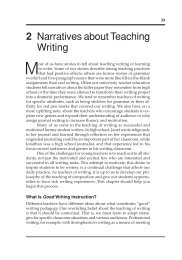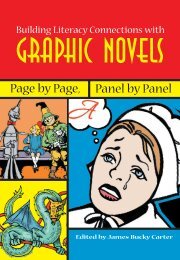Wood_cover.qxd (Page 1) - National Council of Teachers of English
Wood_cover.qxd (Page 1) - National Council of Teachers of English
Wood_cover.qxd (Page 1) - National Council of Teachers of English
- No tags were found...
Create successful ePaper yourself
Turn your PDF publications into a flip-book with our unique Google optimized e-Paper software.
84 Chapter 4weathered brown on brown.Still holding soles and hammermending leather stubborn as my palmsgently drumminggently drumming.Still sweeping slowly as the sunsets before I walk to the plazato watch the stars come out,to watch the girls.Spring again.Prereading: Framing the WorldTo help students understand that a still life is a moment in time, a focusedsnapshot that analyzes small pieces <strong>of</strong> the world, it is useful topractice creating still lifes with them before looking at the poem above.Start by asking students to take a piece <strong>of</strong> paper <strong>of</strong> any size and cut outthe middle to create a frame. I prefer taking students outside for the nextstep, but if that is not an option at your school, students can easily completethis activity right in the classroom. Find a good area where eachstudent can have his or her own space, and ask students to plant themselvesin one spot with their frames, something with which to write, andthe organizer in Figure 4.3. Once they are situated, have them place theirframes somewhere that seems interesting to them and leave it there.(Some students may need to tape their frames to walls, trees, fences, orthe like.) If they can not find an “interesting” place, ask them to findthe most boring space in the area and use that. They will be amazed bywhat they find. The goal is to have students focus on the microworld intheir frames and write about it in as much detail as possible.After students have had time to complete their framing activity,give them a chance to share with each other. While students read theirdescriptions, the class can guess what is being described. Discuss theimportance <strong>of</strong> detail when trying to describe an image accurately, orinversely, when trying to imagine words in picture form.Use the Internet and do a search <strong>of</strong> the words still life with yourstudents to show them what this category <strong>of</strong> art has traditionally lookedlike. You will find a lot <strong>of</strong> dishes <strong>of</strong> fruit and empty furniture in emptyrooms. Focus in on the idea that what the artists are doing is providingnew ways to see ordinary things. Ask students to explain how the stilllife art you find is describing the world. How do the artists use detailssuch as color, shadows, and lines to fully describe the objects? Do theymake the objects bigger or smaller than they would usually be? Howdo these techniques affect the way we see and feel about the objects?
















